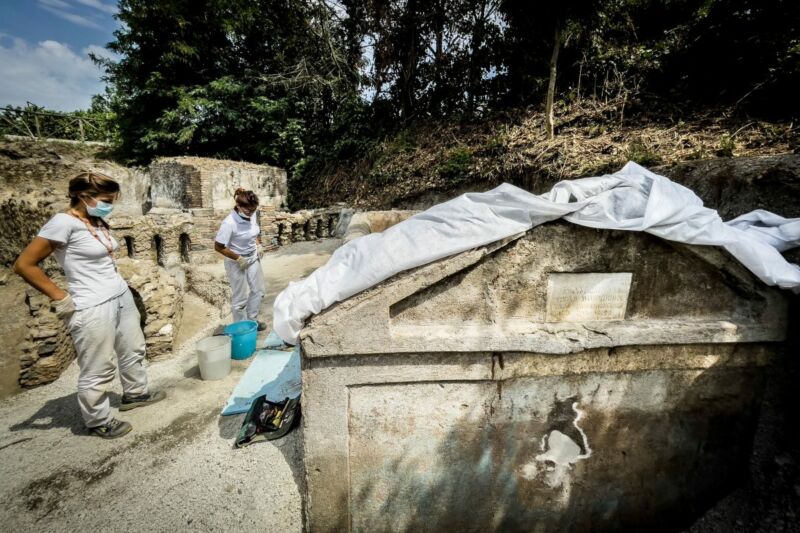
Archaeologists working in Pompeii recently unearthed the tomb and partially mummified remains of a man who died a few decades before the eruption. The man, Marcus Venerius Secundio, according to his epitaph, had once been enslaved, but by the end of his life he’d obtained enough wealth and status to sponsor four days of theater performances in Pompeii.
Rags to riches in Imperial Rome
Archaeologists rediscovered Marcus Venerius Secundio’s tomb in the ancient cemetery, or necropolis, of Porta Sarno in the eastern part of Pompeii, where tourists aren’t allowed. His tomb was large and imposing, with a colorfully painted facade depicting green plants on a blue background; traces of the paint still cling to the stone even after 2,000 years. It was also sealed so well that its occupant’s remains had partially mummified, preserving some soft tissue and a few tufts of white hair, along with some scraps of fabric.
Because Pompeii is both amazingly well-preserved and extensively studied, archaeologists were able to match the name inscribed over the tomb’s entrance to a name on wax tablets in the house of a banker named Lucius Caecilius Jucundus, across the city from the necropolis. The banker’s tablets recorded Marcus as a “public slave” who worked as a custodian in the Temple of Venus, which once stood at the western end of town (that’s almost certainly where the second part of his name, Venerius, comes from). But at some point he became a libertus, or freedman, and began to build a new life for himself.
Slavery in Rome wasn’t always a permanent state, and many liberti went on to build relatively prosperous lives for themselves. Evidence of their history persists all over Pompeii. And the libertus Marcus evidently did quite well for himself indeed; the epitaph carved into the stone over his tomb boasts that he once sponsored four full days of theatrical performances for the people of Pompeii, given in both Greek and Latin.
That seems like an odd thing to brag about on your tombstone, but for affluent Romans, sponsoring public entertainment like plays or gladiatorial matches provided a way of showing off while also cementing one’s popularity and fame. It was philanthropy as both advertisement and power move, a la Carnegie and Rockefeller. By bragging about the plays he’d sponsored, Marcus was asserting that he’d been a mover and shaker in his day.
“Greek and Latin ludi for the duration of four days”
In recording his proudest accomplishment, Marcus also offered a glimpse of the broader cultural life of Pompeii. Greek was the most common language in the eastern Mediterranean in the early centuries CE, and plays and other performances were a huge part of the social scene in cities like Pompeii. But archaeologists haven’t found any other evidence that plays were performed in Greek in this cosmopolitan but solidly Roman city.
“That performances in Greek were organized is evidence of the lively and open cultural climate which characterized ancient Pompeii,” said archaeologist Gabriel Zuchtriegel, director of the Pompeii Archaeological Park.
Plenty of other archaeological and historical evidence paints the buried city as a diverse place, full of people and cultures from around the Roman world. Zuchtriegel described evidence of Greek theater in town as “another tessera of a large mosaic” that was Pompeii’s cultural life.



3175x175(CURRENT).thumb.jpg.b05acc060982b36f5891ba728e6d953c.jpg)

Recommended Comments
There are no comments to display.
Join the conversation
You can post now and register later. If you have an account, sign in now to post with your account.
Note: Your post will require moderator approval before it will be visible.